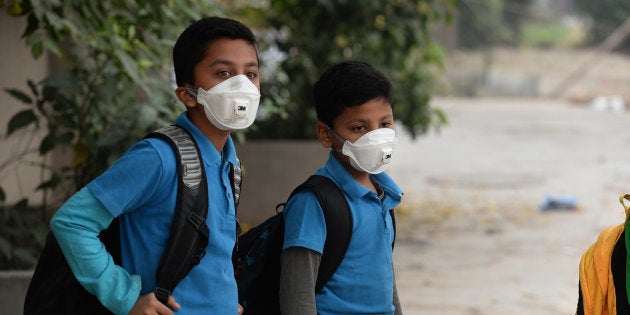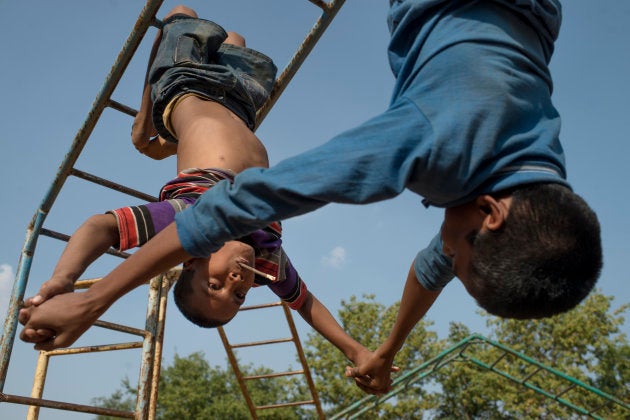
Air pollution, piles of garbage, open electrical wires and chaotic traffic are just a few of the hazards that children in India's cities negotiate every day. While these problems may be an everyday feature of city life, mounting research indicates these urban problems are detrimental to the mental and physical development of children.
These concerns are highlighted by a report on children's quality of life in Bengaluru that was released this month by the Janaagraha Centre for Citizenship and Democracy. Drawing on research involving more than 60 eighth-standard students in 10 schools around Bengaluru in 2015, the report found that children are deeply concerned about how urban infrastructure problems affect their health, safety and opportunities to play.
Urban hazards will prove costly for the Indian economy by harming the mental and physical development of Indian children, more than one-fourth of whom live in cities.
Their concerns include dangerous intersections without crosswalks, footpaths blocked by piles of garbage or electric wires, and roads with no footpaths at all. They also worry about garbage—piling up on sidewalks, in parks and near their schools—that makes it difficult for them to walk around and play safely.
"We can't walk on the roads due to the fast moving vehicles and on top of it we also can't walk on the footpath due to its bad condition," explained one student interviewed by Janaagraha.
More than half of the students in Janaagraha's study also said Bengaluru needs more greenery and parks. Almost all of them were concerned that parks and green spaces in the city are not being well-maintained, are polluted with waste or are filled with hazards, such as open electrical transformers.
Critically, all of these issues restrict the times and places in which children are able to move around the city and play freely and safely. In the worst cases, urban dangers kill.
In 2014, an 8-year-old girl died in Bengaluru after being sucked into a drain on the road during heavy rain. These risks were not lost on those students who spoke to Janaagraha. The deadly hazards they pointed out included open electrical transformers in parks, a sewage canal without protective barriers and speeding cars on their walk to school.
In the long run, urban hazards will also prove costly for the Indian economy by harming the mental and physical development of Indian children, more than one-fourth of whom live in cities.
"Child psychologists are unanimous in agreeing that play is fundamental to children's physical, intellectual, social, and emotional development and that constraints on children's freedom to play can be detrimental in numerous ways," wrote child-rights expert Roger Hart in a paper for the United Nations Children's Fund.

The failure of Bengaluru's government to provide children with adequate places to play may also be a violation of human rights. The "right of the child to rest and leisure" and "to engage in play and recreational activities" are enshrined by the International Convention on the Rights of the Child. These rights were recognised by the Delhi High Court in 2014 when the Chief Justice said the city's parks were so poorly maintained that it was a "serious violation of human rights of children."
Even so, Indian cities have dedicated little to no resources to incorporating children's needs into urban planning. India's national, state and city governments should quickly work together to change that.
The type of urban planning and priorities that are critical to fulfilling children's rights are also ones that will enhance quality of life for all.
They can start paying more attention to urban plans down to the neighbourhood level. In 2015, only one of the 21 major Indian cities, including Delhi, Mumbai and Bengaluru, surveyed for Janaagraha's Annual Survey of Indian City Systems had a ward-level spatial plan. In fact, such little attention has been paid to urban planning that the cities surveyed scored an average of 2.4 out of 10 on the urban planning and design measure. To make matters worse, those plans that cities do have are frequently out of date. For example, the Karnataka Town and Country Planning Act, which governs planning in Bengaluru, dates back to 1961.
What this means in practice is that the authorities are not able to keep up with the pace of urban growth, and infrastructure is constructed in a haphazard fashion. In Bengaluru, such ad hoc development has led to a range of problems for children's safety, health and play, including but not limited to inadequate footpaths, poor roads, electrical hazards and dirty parks.
Moving forward, it is critical for cities to develop coordinated ward-level plans that are responsive to the needs of children and involve coordination between all three levels of government, as well as the urban local bodies responsible for basic service delivery.
One way they can accomplish this is by engaging children in the planning process. Civic education programs like Bala-Janaagraha, a program that teaches eighth-standard students about urban issues, prove this can work. Every year, thousands of Bala-Janaagrahis reach out to city officials to resolve problems affecting them. In many cases, they are successful. Children in cities like Bengaluru, Pune and Patna have convinced authorities to fix broken streetlights, build speedbumps to slow down drivers near their schools and send regular garbage trucks to clean up dirty neighbourhoods.
Finally, authorities can proceed by paying special attention to two key issues limiting children's movement and safety—provisions for pedestrians and the maintenance of high-quality parks. Critically, the type of urban planning and priorities that are critical to fulfilling children's rights are also ones that will enhance quality of life for all.
